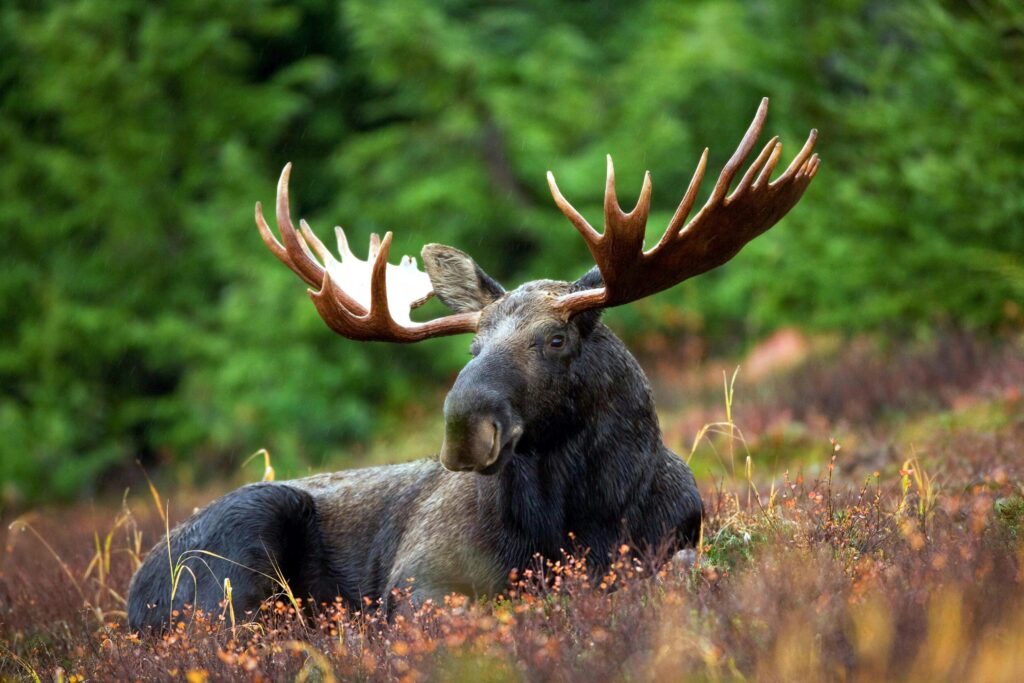Mongolia

Moose resting
Mongolia is a land of extremes — vast, open, and echoing with silence. It’s one of the last places on Earth where true wilderness still feels untouched. Here, under an endless sky, you’ll find golden eagles perched on rocky outcrops, wild horses galloping across the steppe, and snow leopards slinking between jagged mountains. It’s not just remote — it’s raw, resilient, and home to some of the most elusive wildlife on the planet.
What Makes Mongolia Special?
Mongolia offers a rare kind of wildlife experience: one where you can go days without seeing another person but share a landscape with wild camels, ibex, wolves, and even the legendary snow leopard. Its sheer scale means animals still roam free across unbroken terrain. The connection between people and nature is also unique — nomadic herders, golden eagle hunters, and local conservationists live side by side with the wildlife.
Top Wildlife Experiences in Mongolia:
Wildlife Behaviors You’ll Notice Here:
Mongolia’s animals are built for survival. Argali sheep vanish into rocky outcrops. Camels graze calmly in searing heat or snow. Wolves and Pallas’s cats stay out of sight, but their tracks hint at nighttime activity. In open steppe and desert, you rely on sharp eyes and patient guides — and when wildlife appears, it often feels like a personal discovery, not a show.
Rare and Endemic Species:
Mongolia’s remoteness has protected some incredibly rare species:
When to Visit for the Best Sightings:
Spring (April–June) and early autumn (September–October) are the best times for wildlife. Animals are active, landscapes are beautiful, and temperatures are manageable. Winter is extremely harsh but offers rare chances to track snow leopards and see Mongolia’s famous eagle hunters in action.
Threats and Conservation Challenges:
Mongolia’s isolation helps, but wildlife still faces pressures:
Final Reflections:
Mongolia doesn’t hand you wildlife easily — but when it comes, it’s unforgettable. It’s a place of subtle movements, long silences, and sudden, wild beauty. Watching wild horses at dusk or hearing an eagle call across the mountains reminds you that there are still places on Earth where nature is in charge. And in those places, we’re just lucky visitors.
What Makes Mongolia Special?
Mongolia offers a rare kind of wildlife experience: one where you can go days without seeing another person but share a landscape with wild camels, ibex, wolves, and even the legendary snow leopard. Its sheer scale means animals still roam free across unbroken terrain. The connection between people and nature is also unique — nomadic herders, golden eagle hunters, and local conservationists live side by side with the wildlife.
Top Wildlife Experiences in Mongolia:
- Altai Mountains: This rugged, high-altitude region is snow leopard country. While sightings are rare, camera traps and guides are increasing your chances.
- Hustai National Park: Home of the reintroduced Przewalski’s horse — the world’s only truly wild horse. Often seen grazing freely on open grasslands.
- Gobi Desert: Far more diverse than it looks — you can find wild Bactrian camels, Gobi bears, argali sheep, and rare lizards among the dunes and cliffs.
- Ikh Nart Nature Reserve: A rocky plateau where Siberian ibex and argali sheep cling to cliffs, while cinereous vultures circle above.
- Lake Uvs and Wetlands: In the northwest, these freshwater havens attract rare cranes, ducks, and migratory birds in large numbers.
Wildlife Behaviors You’ll Notice Here:
Mongolia’s animals are built for survival. Argali sheep vanish into rocky outcrops. Camels graze calmly in searing heat or snow. Wolves and Pallas’s cats stay out of sight, but their tracks hint at nighttime activity. In open steppe and desert, you rely on sharp eyes and patient guides — and when wildlife appears, it often feels like a personal discovery, not a show.
Rare and Endemic Species:
Mongolia’s remoteness has protected some incredibly rare species:
- Snow Leopard: Iconic and elusive. Best chances to spot are in the Altai Mountains or remote Gobi ranges.
- Przewalski’s Horse (Takhi): Extinct in the wild for decades, now thriving again in Hustai and other reserves.
- Gobi Bear (Mazaalai): One of the rarest bears on Earth — only a few dozen individuals survive in the Gobi.
- Pallas’s Cat: A round-faced feline adapted to cold, dry steppe. Rare but sometimes seen in rocky habitats.
- Siberian Ibex & Argali: Massive wild sheep and goats with curled horns, agile and striking to watch.
When to Visit for the Best Sightings:
Spring (April–June) and early autumn (September–October) are the best times for wildlife. Animals are active, landscapes are beautiful, and temperatures are manageable. Winter is extremely harsh but offers rare chances to track snow leopards and see Mongolia’s famous eagle hunters in action.
Threats and Conservation Challenges:
Mongolia’s isolation helps, but wildlife still faces pressures:
- Poaching and trade: Snow leopard pelts and body parts are still targeted, despite legal protections.
- Mining and development: Expanding roads, mines, and fences interrupt migration routes and habitats.
- Climate change: Droughts, desertification, and extreme winters (dzuds) affect both livestock and wild populations.
- Conflict with herders: Predators like wolves and snow leopards are sometimes killed to protect livestock.
Final Reflections:
Mongolia doesn’t hand you wildlife easily — but when it comes, it’s unforgettable. It’s a place of subtle movements, long silences, and sudden, wild beauty. Watching wild horses at dusk or hearing an eagle call across the mountains reminds you that there are still places on Earth where nature is in charge. And in those places, we’re just lucky visitors.
